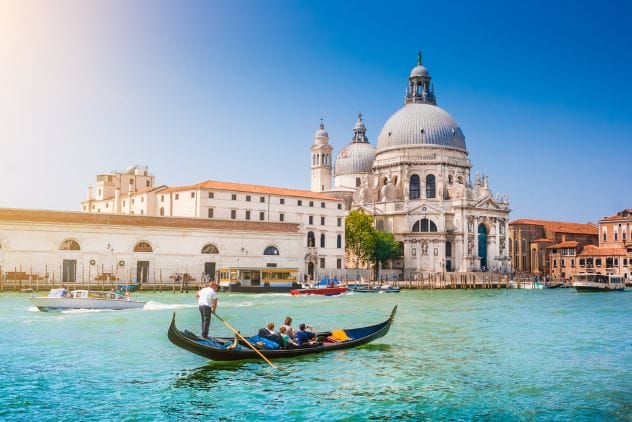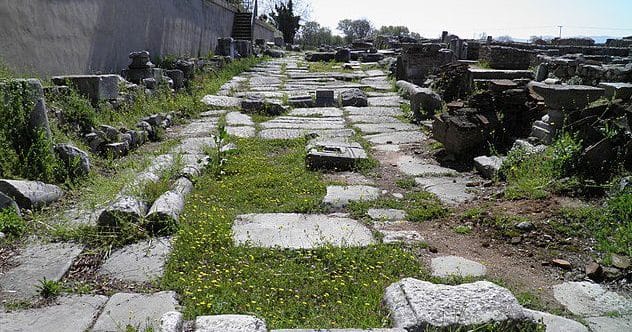Roads. They seem so simple, don’t they? Just a way to get from A to B. But what if I told you that ancient pathways are brimming with mysteries, incredible stories, and truths that will make you see your daily commute in a whole new light? Some of these ancient marvels still exist thousands of years later, whispering tales of forgotten times.
From a highway of tombs that guided the living, to a legendary route that might not have existed as we think, and the curious ways Roman roads still influence us today, get ready to explore 10 fascinating facts that will change how you view the next road you travel!
10. A Submerged Beach Road

Imagine stumbling upon an ancient Roman road, not on land, but at the bottom of the Venetian Lagoon! That’s exactly what happened in 2021. While Roman roads are known for their builders’ skill, finding one here confirmed a long-held suspicion from the 1980s about early settlements.
This incredible road, stretching 3,937 feet (1,200 meters), actually predates the founding of Venice. It connected with other Roman structures like defensive towers, homes, walkways, and even a port. This discovery strongly suggests a large, permanent settlement existed there long ago.
More than just proving a settlement, this underwater road showcases the Romans’ fearless engineering. Building a road on a beach, now submerged, would have demanded immense skill and knowledge of difficult terrains. It’s a testament to their architectural prowess!
9. A Road Built by Pontius Pilate
Archaeologists excavating an ancient street in Jerusalem recently made a fascinating find: coins beneath the road, dropped by its original builders! The minting dates on these coins revealed that the 722-foot (220-meter) long street was constructed during the time Pontius Pilate was the Roman governor of Judea. As the region’s ruler, it’s almost certain he ordered its construction.
This wasn’t just any road; it was magnificent. Used by pilgrims heading to a temple, the 2,000-year-old walkway was an impressive 26 feet (8 meters) wide, meticulously paved with a staggering 11,023 tons (10,000 tonnes) of limestone. This grand road also connected two of Jerusalem’s most sacred sites: Temple Mount and the Siloam Pool.
Why would a Roman governor invest so heavily in a lavish road for the local population? It’s thought that after Rome took Jerusalem by force, this grand project might have been a gesture to soothe the city’s Jewish residents. Of course, building such an impressive road also served to display Pilate’s own wealth and influence.
8. Easter Island’s Enigmatic Roads
Easter Island is world-famous for its mysterious Moai statues, but did you know the island also hosts a network of 800-year-old roads? For a long time, their purpose was a puzzle. In 1914, archaeologist Katherine Routledge suggested they were ceremonial paths. However, being less well-known, her theory was largely overlooked.
Fast forward to 1958, when Norwegian adventurer Thor Heyerdahl proposed that these roads were built solely to transport the giant Moai statues from the quarry to their final spots. He pointed to statues found lying near these roads as evidence of abandonment during transport. This idea gained widespread acceptance.
However, a 2010 discovery turned this theory on its head. Archaeologists found that these statues had actually toppled from hidden platforms, meaning they were at their intended destinations, just a bit weathered. It seems Katherine Routledge was likely correct after all. The roads had a concave shape, which would have made moving the massive statues very difficult, and they also led to a sacred volcano, emphasizing their spiritual importance.
7. A Road That Leads to Stonehenge
Millions have visited Stonehenge, surely beating a path to its majestic stones. But we’re talking about a much older road, one made by Stonehenge’s creators! Hidden beneath the grass, this ancient pathway is known to archaeologists as the “avenue.”
For a while, a key question remained: where did this avenue actually lead? Did it simply pass by the monument, or was Stonehenge its destination? A modern road built over the ancient path complicated things, partially destroying it.
In 2021, researchers carefully dismantled the newer road. This revealed new features of the ancient earthwork. The avenue, about 98 feet (30 meters) wide, did indeed lead directly to Stonehenge for about 0.3 miles (0.5 kilometers). From there, this ancient ceremonial road wound its way for another 1.5 miles (2.4 kilometers) to the Avon River, near the village of Amesbury.
6. Roman Roads Do Something Strange Today
About 2,000 years ago, the Romans constructed their famous road networks primarily to enable swift troop movements. Over time, many of these roads naturally became hubs around prosperous towns and cities. As settlements grew wealthier, more people visited, and more roads were built to handle the traffic.
When the Roman Empire fell, many of its roads vanished. With centuries passing and landscapes changing dramatically, experts assumed there was no link between these ancient highways and modern financial centers. But these Roman roads exhibit a mysterious behavior even today: they continue to cluster around relatively wealthy areas, even the pathways that are long gone!
A 2022 study revealed that the ancient roads appear so consistently around modern economic hubs that it points to a direct connection. It’s highly probable that the prosperity brought by these ancient routes influenced later settlements, towns, and cities to develop and thrive in the same locations.
5. A Road Forged for Conquest
Stretching for an impressive 62 miles (99.7 kilometers) across Mexico’s Yucatán Peninsula is a remarkable ancient road. Built around AD 700, it was the longest road in the region at the time. Recently rediscovered, it’s been dubbed the “white road” due to its reflective limestone paving, which would have made it visible to warriors even in low light.
Speaking of warriors, researchers believe this road was likely commissioned by a powerful warrior queen, Lady K’awiil Ajaw, who ruled the Maya city of Cobá. Known for her expeditions to conquer new territories, it appears this road was specifically built to seize the distant city of Yaxuná.
Indeed, the white road starts at Cobá and leads directly to Yaxuná. By capturing Yaxuná, Queen K’awiil Ajaw would have solidified her control over the peninsula. This was no hastily built path; archaeologists hail its engineering as a marvel, comparable to the famed Mayan pyramids.
4. This Road Saved Maya Villagers
Around 1,400 years ago, the Maya village of Ceren was in the midst of a celebration. As the people prepared their main temple for a ritual, a nearby volcano erupted, completely burying Ceren in ash. This turned the village into a perfectly preserved time capsule. When discovered in 2011 in modern-day El Salvador, researchers found half-eaten meals and all the villagers’ belongings, but astonishingly, no bodies.
The key to their survival? The settlement featured a raised road known as a sacbe. This road ran past the temple and led out of the village, providing the 200-plus residents of Ceren a quick escape route to the south. This was crucial as the volcanic ash plumes approached from the north, eventually engulfing the village.
Beyond its life-saving role, this road was unique. All previously discovered sacbe roads had an outer layer of stones. Ironically, the Ceren road was constructed from ash. This discovery proved for the first time that the Maya didn’t solely rely on stone casings for building these important pathways.
3. A Highway of Graves Guiding the Living
Today, long-distance car travel often involves highways flanked by gas stations and rest stops. Graveyards are rarely a roadside feature. But thousands of years ago in ancient Arabia, for the Bedouin people moving between oases, survival in the arid landscape often meant following their dead.
In 2022, archaeologists unveiled an extraordinary network of ancient highways. About 4,500 years ago, Bedouins traveled along routes lined with burial chambers. These stone-carved tombs served a dual purpose. Some, shaped like pendants, pointed towards the nearest road, helping travelers find the highways. Other graves stood like ancient road signs along the path, clearly marking the way to the next water source.
Interestingly, these tombs also indicated the distance to the next oasis. The closer a road was to water, the more densely packed the graves became. These “funerary highways” were so effective that people could traverse roughly 330 miles (530 kilometers) without succumbing to thirst—a remarkable system of navigation and survival.
2. A Biblical Road Still Traveled Today
In Jordan, a long road meanders through mountains and valleys. Known as the King’s Highway, it’s famously mentioned in the Bible when Moses sought permission from the King of Edom to use it to travel through his land. Remarkably, this highway has been in continuous use since the eighth century BC!
Today, the road has a modern tarmac surface and accommodates cars, bicycles, and pedestrians. But in ancient times, it was a vital link connecting powerful_kingdoms, including Ancient Egypt, Arabia, the Red Sea, and the Fertile Crescent. For thousands of years, pilgrims, merchant caravans, soldiers, and kings used this very route to travel north and south through Jordan’s highlands.
Modern tourists can travel the 154-mile (250-kilometer) highway and experience a stunning array of important historical sites linked by this enduring road. These include Roman ruins, Crusader castles, the ancient city of Petra, Byzantine churches, an Umayyad palace, ancient towns, and the UNESCO World Heritage Site of Umm ar-Rasas.
1. The Silk Road: Not What You Think?
History books are filled with tales of the Silk Road, China’s most famous trade route. So, how could it be a myth? Well, while trade likely occurred along parts of this network, the Silk Road probably wasn’t the grand, unified highway many imagine. It’s more accurate to say it was very different from popular belief.
Historians have traditionally painted it as a 4,000-mile (6,437-kilometer) network connecting China to the world, facilitating the exchange of fine silk and other treasures. However, some modern scholarship suggests China didn’t widely export silk during the supposed peak of the Silk Road, nor did they engage extensively in foreign trade via this route. They didn’t even call it the “Silk Road” – that name came much later.
Furthermore, far from being an easy passage, parts of the route were often poorly maintained, difficult to traverse, and remained largely unused for long periods. So, while the idea of the Silk Road is evocative, its historical reality is much more complex and perhaps less singular than its legendary status suggests.
These ancient roads are far more than just lines on a map. They are a testament to human ingenuity, ambition, and the enduring need to connect, explore, and survive. Each path tells a story, revealing that even the most ordinary-seeming things can hold extraordinary secrets from our past.
Which of these ancient road facts surprised you the most? Share your thoughts in the comments below!










